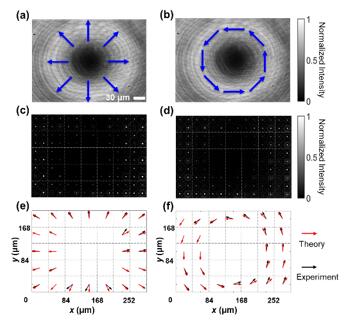The amplitude, phase, frequency and state of polarization (SOP) are fundamental parameters for describing light waves. The real-time measurement of the polarization and phase information of light is very important and desirable in optics. At present, however, most photodetectors are only sensitive to the light intensity, which makes traditional polarization and phase detection systems complex, bulky and difficult to integrate. Metasurfaces are ultrathin two-dimensional metamaterials with subwavelength features that can flexibly manipulate the amplitude, phase, and SOP of the light,and can therefore be exploited to develop compact optical devices to replace traditional optical elements, producing a highly integrated and extremely compact optical system. Compared with plasmonic metasurfaces, dielectric metasurfaces have less loss for transmission operation, making them more suitable for visible and NIR wavelengths. As one of the most popular directions in the field of metasurface-based optics, metalenses offer the advantages of higher compactness and no spherical aberrations compared with traditional lenses. The fabrication of these planar metalenses is straightforward, easy to integrate, and can potentially replace or complement their conventional refractive and diffractive counterparts, facilitating further miniaturization of high-performance optical devices and systems.
Recently, the groups of Prof. Jinsong Xia and Prof. Zhenyu Yang of Huazhong University of Science and Technology published an article in the journal of Photonics Research, Volume 8, Issue 4, 2020 (Editors’ Pick) and introduced an efficient and compact optical multiparameter detection system based on a Hartmann-Shack array with 2×2 sub-array metalenses (see Figure 1), operating at 1550nm. This system not only enables the efficient and accurate measurement of the spatial polarization profiles of optical beams via the inspection of foci amplitudes but also measures the phase and phase-gradient profiles by analysing foci displacements.

Figure 1. Schematic shows the high-efficiency optical multiparameter detection system.
The proposed optical multi-parameter detection system consists of a dielectric metalens array and a camera. The unit element of the metalens is an elliptical silicon pillar placed on a layer of silica. The metalens array contains multiple pixels, and each pixel contains four different metalenses that can separate four differently polarized components from the incident beam and converge these components onto the camera. Then, the phase and SOP profiles of the beam can be derived from the position and intensity information of each focal spot. In addition, by designing and optimizing the unit cell of each metalens, a high average focusing efficiency of 48% can be obtained. In the experiments, authors first accurately characterize the SOP of 22 different incident polarized beams by one pixel of the array. The average relative error between the theoretical results and experimental results is as small as 4.24%. Next, authors detect two common light beams with non-constant SOPs (a radially polarized beam and an azimuthally polarized beam) and a vortex light beam with a spiral wavefront, demonstrating that this design is also applicable to beams with complex SOPs and wavefronts (see Figure 2 and 3).

Figure 2. Detection and reconstruction of two vector beams.

Figure 3. Detection and reconstruction of the vortex beam.
The authors believe that this optical multiparameter detection system is very compact and can realize the real-time detection of the SOP and wavefront distributions of the incident beam, which has important application potential and value in optical imaging and optical probing. By replacing silicon with another dielectric, the operation principle can be transferred to other operation wavelengths.
Wang Yuxi, a doctoral student at the Wuhan National Laboratory for Optoelectronics, and Wang Zhaokun, a doctoral student at the School of Optical and Electronic Information, are co-first authors of the paper. The research was supported by the State Key Laboratory of Advanced Optical Communication Systems and Networks, and the National Natural Science Foundation of China.
Article Link: http://www.osapublishing.org/PRJ/abstract.cfm?uri=PRJ-8-4-482